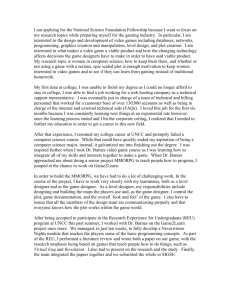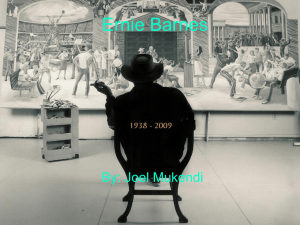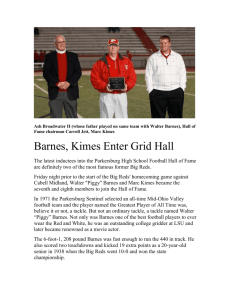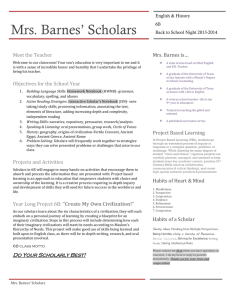DAUPH I NE STREET JAM SESSION
advertisement
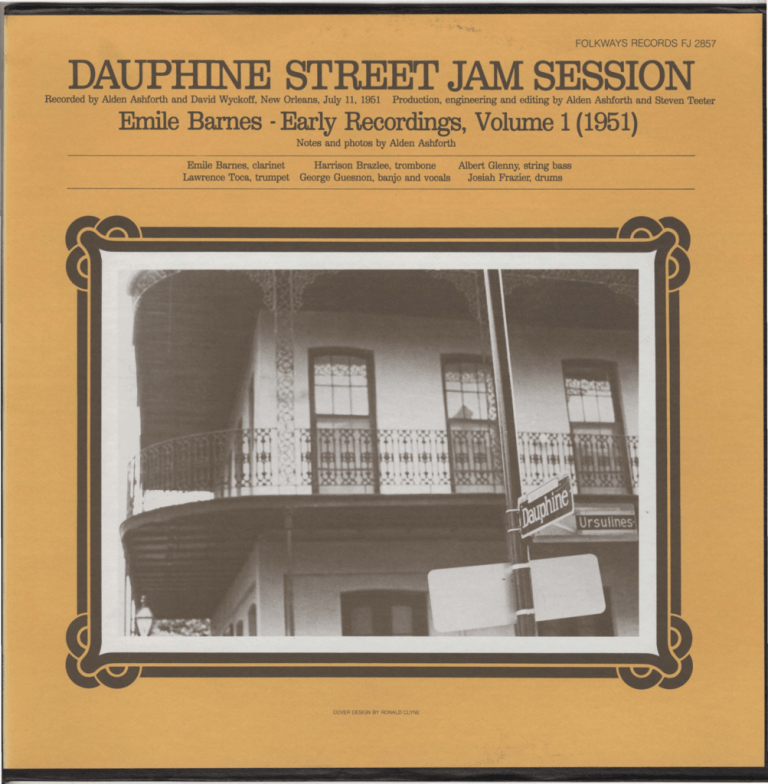
FOLKWAYS RECORDS FJ 2857 DAUPH I NE STREET JAM SESSION Recorded by Alden Ashforth and David Wyckoff, New Orleans, July 11, 1951 Production, engineering and editing by Alden Ashforth and Steven Teeter Emile Barnes -Early Recordings, Volume 1 (1951) Notes and photos by Alden Ashforth Emile Barnes, clarinet Harrison Brazlee, trombone Albert Glenny, string bass Lawrence Toca, trumpet George Guesnon, banjo and vocals Josiah Frazier, drums COVER DESIGN BY RONALD CLYNE FOLKWAYS RECORDS FJ 2857 DAUPHINE STREET JAM SESSION SIDE ONE: 1. I Can't Escape From You (Robin-Whiting) 3:52 2. St. Louis Blues (W.C. Handy) 4:00 3. A Porter's Love Song to a Chambermaid (Fats Waller) 3:30 4. Hindustan (Weeks-Wallace) 2:20 5. Some of These Days (Shelton Brooks) 3:28 SIDE TWO: 1. 2. 3. 4. 5. 6. See See Rider (Arant-Rainey) 3:28 St. Louis Blues (alt. take) 2:10 Mil neberg Joys (Armstrong-M orton) 3:04 Carless Love Blues (traditional) 4:05 The Sheik of Araby (Snyder-Smith-Wheeler) High Society (Porter Steele) 3:05 2:30 DAUPHINE STREET JAM SESSION Emile Barnes - Early Recordings, Volume 1 (1951) Recorded by Alden Asbforth and David Wyckoff, New Orleans. July 11. 1951 Production. engineering and editing by Alden Asbforth and Steven Teeter Notes and photos by Alden Asforth DESCRIPTIVE NOTES ARE INSIDE POCKET FOLKWAYS RECORDS FJ 2857 FOLKWAYS RECORDS Album No. FJ2857 © 1983 by Folkways Records & Service Corp., 43 West 61st St., NYC, USA 10023 seated (left to right): Lawrence Thca, Cie Frazier, Harrison Brazlee, George Guesnon, Emile Barnes standing: Albert Glenny EMILE BARNES: THE FIRST SESSION These recordings, made in the summer of 1951 but never before issued, were the first of Emile Barnes and the first David Wyckoff and I made in New Orleans. Our aim was to document musicians not already represented on disc and Barnes, then in his sixtieth year and a veteran of the legendary bands of Buddie Petit and Chris Kelly, was a clear choice. Although we had heard glowing reports from Dick Allen about Barnes playing at the Harmony Inn in the late forties, my first contact with him came about through Lawrence Marrero of the George Lewis band. I had been taking lessons from George for a while and occasionally sat in with the band at Manny's Tavern, and had got to know Lawrence well enough to drop over to his house nearby at 907 Burgundy Street to chat. One evening, sitting on the front steps playing with his granddaughter, he suggested that even though I was "George's boy" I might like to meet his cousin "Mill" who played "a lot of clarinet". (Lawrence's father Billy was Barnes's uncle and the cousins, less than two years apart in age, had been close.) I was given a phone number and the admonition not to breathe a word to George - not even to mention the name Barnes. "Bad blood between them" was Lawrence's only explanation. Barnes turned out to be immediately friendly on the phone once the name of Marrero was mentioned and promised to call when he had playing dates. And so we came to start hearing him frequently, first at Luthjen's with Didi Pierce, but far more often at Fump and Manny's, a small unassuming beer-and-dancing establishment on the corner of Lyons and 'IChoupitoulas in the lower middle-class white "Irish Channel" neighborhood. (Black bars by that time had lost interest in traditional jazz, having modernized to juke-boxes featuring rhythmand-blues.) Abby Williams, a drummer of modest abillty but a shrewd manager, provided the non-union band, usually with George Guesnon, recently returned from Harlem, playing an over-amplified "electric" guitar. Generally Kid Howard was on hand, playing well when sober and always having a good time. But it was Barnes who dominated the ensemble, musically and physically: a tall figure of proudly erect posture, jet-black skin and sparkling eyes, a man of temperament and commanding presence. Mill (rhymes with "freely") had a unique style of playing. On the fast numbers he would sound very Creole, peppering his lines with short perky figures, interjecting double-tongued repeated notes, and often answering the trumpet or vocal lead with short motives played twice - a very French characteristic. In a moderate tempo he would often assume the melodic lead (he later recalled, in an interview at Thlane University, that in the old days if there was no violin in a band the clarinet took the lead, never truck, which doubled as transportation for fellow musicians' instruments on the weekend gigs. the trumpet). In the slow blues, for which he was justly famous, he became overpoweringly soulful, wailing and sliding with throaty intensity. His tone in the upper register had a cutting edge to it (he had recently switched to plastic reeds); it was less a "pretty" sound than an energetic and exciting one. In the low chalumeau register, the exploitation of which he claimed to have introduced to jazz, he took on a compelling vibrancy comparable to that of his old friend Sidney Bechet, with whom he used to sneak into Storyville as a kid. The playing was wholly gripping- not so much in surface beauty, but alternately by its gaiety and energy, or by its heart-rending urgency, immediacy and conviction. "In the old days," Barnes told Dick Allen at Thlane University, "a musician would have the blues, and then he would go out and play them." The Barnes style was the quintessence of the black culture of the city; nothing could be further removed from the polite noodlings and doodlings of the Dixieland clarinetists playing the clubs on Bourbon Street. YOUR MATI'RESS IS NEVER OW, OR TOO OW SUCH A COMFORT I I WHEN A MATTRESS IS BUILT BY E. BARNES MATTRESSES OF ALL KINDS MOSS, FELT, BOX SPRING, INNER SPRING, HAIR AND LAYER FELT BOX CUSHIONS AND WINDOW SEATS All Work GuaraDteed Call For aDd Delber 2021 LAHARPE STREET PIIONE BY. 8-498 NEW ORLEANS, LA. Emile Barnes's business card I recall one evening with particular vividness. The make-up of the band was unusual in that it had two clarinets; Abby Williams hadn't .b een able to find a trumpet so he got Albert Burbank as a second clarinetBarnes mostly played lead. Dick Allen arrived with his trombone and also with a pint of whiskey, which pleased the musicians immensely. It was at the end of one such happy evening that David Wyckoff and I asked Mill about the possibility of a recording session. He was delighted and suggested that we drop by his apartment at 2021 La Harpe Street the next afternoon to talk about it. The apartment was small, and Mili's wife Enola was trying to get some housework done, so he suggested that we might go off to a nearby bar. The bartender was at first reluctant to admit us, fearing problems with authorities if he served "white boys" in a "colored" establishment, but Mili managed to persuade him, assuring him that there wouldn't be a "humbug" (troublesome situation). We were brought tumblers and a jug of inexpensive red wine (Mili called it "blood") and began to sip and talk. Where to record was the first question. David and I had just begun sharing a second-floor apartment on the corner of Dauphine and U rsulines in the French Quarter (shown on the album's cover photo). It had been inherited from Bob Cass, who'd moved elsewhere, and had a living room just large enough to hold a band. Studios which would allow recording of black musicians were scarce, and there was the financial aspect. Personnel was the next consideration. Mili thought Kid Howard was unreliable, and preferred for trumpet either Didi Pierce with whom he'd played at Luthjen's or Lawrence 'Thea (whose real name, according to Dick Allen, was Martin). But Didi usually worked as a team with his pianist wife Billie, and the apartment had no piano. So we decided to aim for a later session with Didi and Billie, but this time use Thca, with whose uncle, the trombonist Ambrose Powers, Mill had got his first job. Thca, who had been a pupil of Chris Kelly, was now fifty and playing well; he and Barnes had played together at the Harmony Inn and in Little Woods. Mili was enthusiastic about getting Harrison Brazlee, a veteran of the Evan Thomas band, on trombone. Brazlee Emile Barnes was born on February 18, 1892 at Clouet and Claiborne. He said he was "crazy" about the playing of George Baquet when he was "coming up" and studied a bit with him and also with Alphonse Picou and "Big-Eye" Louis Nelson. But his primary teacher was Lorenzo Tio, Jr., from whom he picked up, among other things, the trick of shaving the edge off the reed in order to darken the tone. As a young player he was known as "Bird", and in addition to featuring the low register his trademark was the use of a felt derby to mute the instrument for inflection. He never read music fluently but had a fine musical memory and had learned the Red Back Book by heart in order to play rags. He admired the playing of his nearcontemporary Jimmie Noone (whom he called "Jimbo") but said he could cut both Dodds and Noone; he claimed once to have forced Noone to jump off an advertising wagon in defeat after a cutting contest. Bunk Johnson, who bought Barnes his first clarinet and gave him a few music lessons, was an especial favorite: the best of all New Orleans cornetists in every way, he felt. Early on Mili played with Wooden Joe Nicholas (who said that the young clarinetist was "the best - no one in the city could touch him") but it was with two other cornetists, Chris Kelly and Buddie Petit, that he really made his mark. He joined Kelly in 1919 and was with him throughout the twenties; the band must have been an extraordinary one, as both men were acknowledged to be supreme in the blues on their respective instruments. The association with Petit was peripatetic; Barnes had a fierce temper, aggravated by hard drinking, and ultimately was replaced by George Lewis - hence the "bad blood" between the two clarinetists. During the depression years Mili turned to rebuilding mattresses as a trade, and although he was playing more by the late forties he kept up the one man business, operating out of his "factory", a shed at 3610 Louisa Street (now Metropolitan) "back of Desire", on a property where he later built a house. He was often to be spotted picking up and delivering the mattresses in his faded blue panel- 2 was by this time sixty-two and still playing strongly in his rough old-time tailgate style, at Luthjen's and on parades. Albert Glenny, who at eighty-one had for decades played with virtually every important musician in the city including Bolden, was the choice for bass. He was presently working mostly at house-painting and odd jobs. Glenny had recorded with Kid Rena in 1940, but certainly deserved further representation on disc. handed: "don't touch that, I know what I'm doing - this is my business!" For the rest of the evening he played with one foot on a mattress carefully protected by newspaper. Lining up the rest of the rhythm section was more problematic. Mill didn't think much of Abbey Williams as a drummer and wanted his cousin Cie Frazier, who at forty-seven was highly experienced, in peak form, and much in demand. Cie had recorded with Celestin as early as 1927, and with Joe Nicholas for Bill Russell in 1944. We were fortunate that Mill was able to induce him to join the group. Most difficult was finding a banjo player. Lawrence Marrero was out of the question because of his commitment to the George Lewis band; there were few others available. Mill didn't mind George Guesnon, but Guesnon had since 1949 become addicted to the amplified guitar, a sound that Barnes absolutely loathed. '''fung!:' he'd mimic, "TUNGGG!" shaking his head in disgust. It was finally decided that David and I would have the j ob of persuading Guesnon to use his tenor banj 0 for a change. Over more red wine we sketched out a short list of tunes we'd heard Barnes playa lot: I Can't Escape from You and of course St. Louis Blues at which Mili couldn't be beat in our opinion. He suggested a personal favorite, Hindustan, and we left the rest to wait until the session. George Guesnon, when we visited him at his home on 1012 North Roman soon after, seemed puzzled that we'd want the archaic banjo, but he hauled it out to demonstrate for us and finally, with reluctance, agreed: he wanted to play the date. He'd recorded in New York (including a rare under-the-counter disc) but never in New Orleans, and he liked the line-up. He even came up with a name he liked for the band - "The Storyville Ramblers". We didn't know how this would sit with Barnes who always liked to call his groups "Louisiana J oymakers," and any connection of this session with the long defunct redlight district was beyond us. George Guesnon and Emile Barnes We conceived of the evening as a cross between a j am session and a trial-run recording session; we'd bought refreshments to party a bit later on, and had invited two interested friends who had indirectly helped make possible the event: Lawrence Marrero and Bob Casso Soon everyone settled down, and once again the band turned to Can't Escape. A particularly fine performance of St. Louis Blues followed, with Barnes taking the traditional clarinet solo (first recorded by Larry Shields) in a strikingly bold and vibrant fashion. George Guesnon wanted a tune he'd picked up in Harlem, Fats Waller's A Porter's Love Song to a Chambermaid; Mill called for Hindustan, a great favorite of his, and Brazlee requested Some of these Days for he had some special shouting licks that he always played. Some time later I sent Guesnon a photo taken at the session and, thinking it would tickle him, wrote "The Storyville Ramblers" at the bottom. The photo, and no doubt George's reminiscences, found its way to England, which may explain why the session is so listed (with Can't Escape as the only tune) in 'Ibm ~tagg's and Charlie Crump's invaluable New Orleans: The Revival. The session took place on the sweltering New Orleans evening of Wendesday, July 11, 1951; 'Ibca and Brazlee immediately stripped down to undershirts. The band warmed up with Can't Escape, and adjusting the Magnecord fYI'1 tape recorder I caught a sizeable fragment of it. On playback the acoustic seemed overly bright, so we decided to dampen the room a bit by blanketing a wall and putting mattresses from the bedrooms on the floor. Mill insisted on carrying in the mattresses single- At this point the upstairs neighbors appeared at the door complaining of the noise. We solved the problem by inviting them to join us for the refreshments, breaking out the wine, beer and a bottle of Seagram's Seven-Crown. Lawrence Marrero paternally scolded David and myself for partaking of the latter; he felt we were too young for whiskey drinking. He enjoyed a glass of it himself though, 3 I'm the Sheik of Araby Your love belongs to me. At night when you're asleep Into your tent I'll creep. The stars that shine above Will light our way to love. Yozlll rule this land with me The Sheik of Araby. Bob Cass said "How about High Society?" The band agreed and launched into a rollicking rendition, Barnes surprising us with a variant of the traditional clarinet obbligato that was quite his own. Everyone broke into spontaneous applause at the end. Thca reluctantly drained his final glass and packed up his trumpet - his wife didn't like him staying out late. Some of the musicians hung around a bit longer to hear playbacks, but the memorable evening all too soon came to a close. Alden Ashforth Departmen t of Music University of California Los Angeles September 1982 Emile Barnes and Bob Cass and Lawrence Thca enjoyed several. Mill was in a fine mood and spent a good bit of time joking with Bob Cass, of whom he was particularly fond. The recording resumed with a take of See See Rider followed by alternate takes of numbers already recorded. The one of St. Louis Blues turned out to be especially interesting as the band took it up-tempo in parade style. 'fuming to the slower blues they started with some traditional twelve-bar choruses, but Lawrence Thca went into Careless Love which, being a Chris Kelly pupil, he loved to play. The Seagram's whiskey, which he was still working on, showed its influence in the reckless sentimental playing, playing of the sort shuffiing dancers might have heard well after midnight in one of the old social halls years ago. Thca sobered up enough for some fast numbers and at Mill's suggestion they took up Milneberg Joys in a jaunty tempo and with saucy breaks. George Guesnon wanted to sing a vocal on The Sheik of Araby (he pronounced it "arrowbee"), and in the time-honored fashion other members of the band chimed in to sing "without no pants on" after each phrase: seated (left to right): Lawrence Thca, Cie Frazier and Harrison Brazlee listen to a playback while the neighbors enjoy refreshments LITHO IN U.S.A. ~- 4

